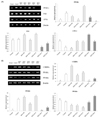1. Ha JO, Park KY. Comparison of mineral contents and external structure of various salts. J Korean Soc Food Sci Nutr. 1998; 27:413–418.
2. Lee HM, Lee WK, Jin JH, Kim IC. Physicochemical properties and microbial analysis of Korean solar salt and flower of salt. J Korean Soc Food Sci Nutr. 2013; 42:1115–1124.

3. Lee SM, Chang HC. Growth-inhibitory effect of the solar salt-doenjang on cancer cells, AGS and HT-29. J Korean Soc Food Sci Nutr. 2009; 38:1664–1671.

4. Park JW, Kim SJ, Kim SH, Kim BH, Kang SG, Nam SH, Jung ST. Determination of mineral and heavy metal contents of various salts. Korean J Food Sci Technol. 2000; 32:1442–1445.
5. Seo JH, Kim HJ, Lee SP. Evaluation of the chemical compositions of solar salts produced in Korea. Korean J Food Preserv. 2012; 19:554–559.

6. Zhao X, Kim SH, Qi Y, Kim SY, Park KY. Effects of different kinds of salt in the comutagenicity and growth of cancer cells. J Korean Soc Food Sci Nutr. 2012; 41:26–32.

7. Jung KO, Lee KY, Rhee SK, Park KY. Effects of various kinds of salt on the tumor formation, NK cell activity and lipid peroxidation in Sarcoma-180 cell transplanted mice. J Korean Assoc Cancer Prev. 2002; 7:134–142.
8. Ha JO, Park KY. Comparison of autooxidation rate and comutagenic effect of different kinds of salt. J Korean Assoc Cancer Prev. 1999; 4:44–51.
9. Lee KD, Gao TC, Bang MA, Cho JY, Ham KS. Effects of a mineral-rich solar salt on blood pressure in Dahl salt-sensitive rats. In : Congress of Korean Society of Food Preservation; 2008 Nov 7; Gwangju, Korea. Daegu: The Korean Society of Food Preservation;2008. p. 325–326.
10. Hida K, Wada J, Eguchi J, Zhang H, Baba M, Seida A, Hashimoto I, Okada T, Yasuhara A, Nakatsuka A, Shikata K, Hourai S, Futami J, Watanabe E, Matsuki Y, Hiramatsu R, Akagi S, Makino H, Kanwar YS. Visceral adipose tissue-derived serine protease inhibitor: a unique insulin-sensitizing adipocytokine in obesity. Proc Natl Acad Sci U S A. 2005; 102:10610–10615.

11. Kunitomi M, Wada J, Takahashi K, Tsuchiyama Y, Mimura Y, Hida K, Miyatake N, Fujii M, Kira S, Shikata K, Maknio H. Relationship between reduced serum IGF-I levels and accumulation of visceral fat in Japanese men. Int J Obes Relat Metab Disord. 2002; 26:361–369.

12. Mitchell M, Armstrong DT, Robker RL, Norman RJ. Adipokines: implications for female fertility and obesity. Reproduction. 2005; 130:583–597.

13. Ju J, Song JL, Park KY. Antiobesity effects of bamboo salt in C57BL/6 mice. J Med Food. 2015; 18:706–710.

14. Qi YC. Effect of bamboo salt on anti-skin aging and antitumor activities transplanted with sarcoma-180 cells in mice [master's thesis]. Busan: Pusan National University;2013.
15. Barnard TW, Crockett MI, Ivaldi JC, Lundberg PL, Yates DA, Levine PA, Sauer DJ. Solid-state detector for ICP-OES. Anal Chem. 1993; 65:1231–1239.

16. Choi HK, Won EK, Jang YP, Choung SY. Antiobesity effect of Codonopsis lanceolata in high-calorie/high-fat-diet-induced obese rats. Evid Based Complement Alternat Med. 2013; 2013:210297.
17. Horton JD, Bashmakov Y, Shimomura I, Shimano H. Regulation of sterol regulatory element binding proteins in livers of fasted and refed mice. Proc Natl Acad Sci U S A. 1998; 95:5987–5992.

18. Choi BH, Ahn IS, Kim YH, Park JW, Lee SY, Hyun CK, Do MS. Berberine reduces the expression of adipogenic enzymes and inflammatory molecules of 3T3-L1 adipocyte. Exp Mol Med. 2006; 38:599–605.

19. Baudrand R, Campino C, Carvajal CA, Olivieri O, Guidi G, Faccini G, Vöhringer PA, Cerda J, Owen G, Kalergis AM, Fardella CE. High sodium intake is associated with increased glucocorticoid production, insulin resistance and metabolic syndrome. Clin Endocrinol (Oxf). 2014; 80:677–684.

20. Winzell MS, Ahrén B. The high-fat diet-fed mouse: a model for studying mechanisms and treatment of impaired glucose tolerance and type 2 diabetes. Diabetes. 2004; 53:Suppl 3. S215–S219.
21. Gregoire FM, Smas CM, Sul HS. Understanding adipocyte differentiation. Physiol Rev. 1998; 78:783–809.

22. Shao D, Lazar MA. Peroxisome proliferator activated receptor gamma, CCAAT/enhancer-binding protein alpha, and cell cycle status regulate the commitment to adipocyte differentiation. J Biol Chem. 1997; 272:21473–21478.

23. Song S, Attia RR, Connaughton S, Niesen MI, Ness GC, Elam MB, Hori RT, Cook GA, Park EA. Peroxisome proliferator activated receptor alpha (PPARα) and PPAR gamma coactivator (PGC-1α) induce carnitine palmitoyltransferase IA (CPT-1A) via independent gene elements. Mol Cell Endocrinol. 2010; 325:54–63.

24. Jain N, Minhajuddin AT, Neeland IJ, Elsayed EF, Vega GL, Hedayati SS. Association of urinary sodium-to-potassium ratio with obesity in a multiethnic cohort. Am J Clin Nutr. 2014; 99:992–998.

25. Zhou MS, Nishida Y, Yoneyama H, Chen QH, Kosaka H. Potassium supplementation increases sodium excretion and nitric oxide production in hypertensive Dahl rats. Clin Exp Hypertens. 1999; 21:1397–1411.

26. Weidemann BJ, Voong S, Morales-Santiago FI, Kahn MZ, Ni J, Littlejohn NK, Claflin KE, Burnett CM, Pearson NA, Lutter ML, Grobe JL. Dietary sodium suppresses digestive efficiency via the renin-angiotensin system. Sci Rep. 2015; 5:11123.










 PDF
PDF ePub
ePub Citation
Citation Print
Print


 XML Download
XML Download